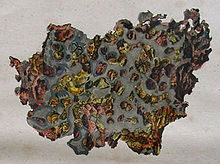Krasnoyarsk (meteorite)
The Krasnoyarsk meteorite was the first known find of a meteorite in Russia . He is assigned to the group of Pallasite .
In 1772, the German explorer Peter Simon Pallas heard about a massive iron body on his Russia expedition, which, according to the stories of Tatars living there, had fallen from the sky in 1749 near the Siberian village of Ubeisk (around 145 km south of the city of Krasnoyarsk ). Pallas examined and sampled the object on the spot. Outside it was surrounded by a black crust, the inside consisted of a strange mixture of olivine crystals embedded in a mass of iron. Nothing like this had ever been seen before.
Without knowing it, Pallas had not only discovered a particularly large and interesting meteorite on his journey, he also made many important contributions to the then still young and controversial meteorite research in the following years when investigating the find material . Nevertheless, the find, which entered the historical literature as "Pallas iron", was only recognized and classified as a meteorite and thus as extraterrestrial matter many years later . It was already used by the physicist Ernst F. F. Chladni at the end of the 18th century to underpin his progressive observations on meteors , fireballs and unusual rock finds, the origin of which, unlike many other of his contemporaries, he did not seek on earth or in the earth's atmosphere , but in distant space .
"Krasnoyarsk" is also the first known representative of a new subgroup of stone-iron meteorites , which were named " Pallasites " after their discoverer . On this meteorite material, the characteristic of many iron and stone-iron meteorites, the “ Widmanstättenschen figures ” (characteristic etching patterns on polished sections after treatment with dilute nitric acid), was researched for the first time. The total mass of the block was originally around 700 kilograms, numerous fragments that were separated for research and collection purposes are now stored in large meteorite collections all over the world. The remaining main mass of the meteorite (approx. 515 kg) is now in the collections of the Russian Academy of Sciences in Moscow .
See also
literature
- Entry in the database of the Meteoritical Bulletin
- Chladni E. About the origin of the iron masses found by Pallas and others similar to it, and about some natural phenomena connected with them. Riga: Hartknoch, 1794. 63 pp.

